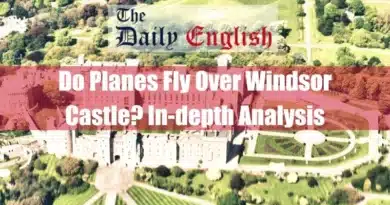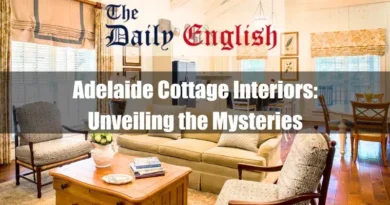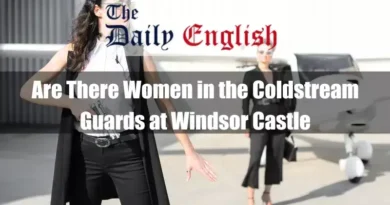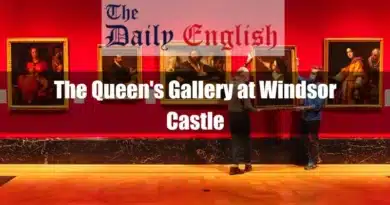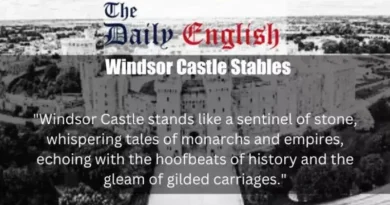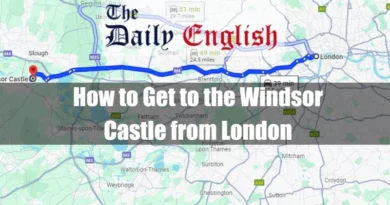King Charles III Presides Over a Vibrant Windsor Castle
Though not a traditional household, Windsor Castle remains surprisingly lively. King Charles III now reigns as its official resident. News sources suggest that Prince William and Kate Middleton may inherit it in the future, but there’s no confirmation on the timeline.
Beyond royalty, a dedicated community of roughly 150 individuals call it home. This includes housekeepers, gardeners, and the Superintendent’s team, all essential for the castle’s upkeep. The historic St George’s Chapel boasts resident clergy, including a Dean, Canons, and other staff who run the collegiate church.
Retired service personnel uphold their honorary positions as the Military Knights of Windsor. Additionally, the castle welcomes temporary residents – esteemed guests during state visits and dedicated staff managing official events and ceremonies. This unique blend of permanent staff, potential future royals, and transient individuals ensures Windsor Castle remains a vibrant activity hub steeped in its rich history and dynamic present.
I. Unveiling the Inhabitants of Windsor Castle
Windsor Castle, a behemoth of history with its towering walls and regal demeanour, might evoke a singular image: the British monarch residing in opulent splendour. While King Charles III does indeed hold the title of its official resident, the reality within its walls unfolds like a diverse, dynamic tapestry. This first glimpse explores the various threads woven into this tapestry, focusing on who actually “lives” in Windsor Castle, stretching far beyond just the royal family.
A. The Current Monarch: King Charles III and the Future
Since inheriting the castle from Queen Elizabeth II, King Charles III is the official resident. However, Windsor Castle is not currently his primary residence. Future plans remain unconfirmed, leaving room for speculation. Will he establish a stronger presence at Windsor or designate it for future generations? Prince William and Kate Middleton are next in line for the throne, so their potential residency adds another layer of intrigue.
B. Beyond the Throne: Potential Future Royal Residents
While the future holds uncertainties, Windsor Castle might continue to house extended royal family members. Private apartments exist within the vast complex, potentially serving as future abodes for these individuals. This possibility further underscores the castle’s multifaceted nature as a royal residence and a potential haven for the wider royal circle.
Related articles:
- Are There Guided Tours of Windsor Castle
- The Windsor Castle Fire 1992: A Historical Catastrophe.
- St. George’s Chapel at Windsor Castle in History & Today.
II. The Permanent Residents – Pillars of Daily Life
Beyond the transient presence of royalty, a dedicated community forms the backbone of Windsor Castle’s daily life. Roughly 150 individuals call this historic landmark their permanent home, each playing a crucial role in its smooth functioning and upkeep. Let’s delve into the lives of these individuals, categorized by their specific contributions:
A. The Castle Community: A Hive of Activity
This diverse group encompasses various individuals crucial to the castle’s operations. Housekeepers ensure pristine living quarters, tending to both State Apartments and private spaces. Gardeners meticulously maintain the sprawling grounds, preserving the castle’s picturesque landscape. The Superintendent’s team, led by the Superintendent himself, oversees the administration, ensuring everything runs seamlessly behind the scenes. Additionally, the Dean and Canons of St George’s Chapel reside within the grounds and are responsible for the spiritual life of the castle and its community.
B. The Military Knights of Windsor: Guardians with a Special Connection
A unique thread in the castle’s tapestry is the Military Knights of Windsor. These 13 retired service personnel hold honorary positions within the castle, residing there with their spouses. Their presence reflects the deep historical connection between the monarchy and the armed forces, adding a touch of tradition and respect to the castle’s atmosphere.
C. The Clergy of St George’s Chapel: Spiritual Stewards of the Grounds
The Dean and Canons of St George’s Chapel add a spiritual dimension to the castle’s community. They reside within the castle grounds, overseeing the chapel’s daily operations and religious services. Their presence further emphasizes the historical significance of the chapel, serving as a sacred space within the castle walls.
Related articles:
- Are Babies Free for Windsor Castle
- How to Get to the Windsor Castle from London
- Queen Mary’s Dollhouse at Windsor Castle.
- Windsor Great Park: A Legacy of History, Nature, and Royal Heritage.
III. Temporary Residents – Adding Vibrancy and Purpose

While the permanent residents ensure the castle’s daily pulse, temporary residents add bursts of activity and purpose. These individuals fall into two main categories: those involved in state visits and official events.
A. State Visits: Welcoming Dignitaries and Royalty
On occasions of state visits, Windsor Castle hosts esteemed guests from around the World. From heads of state to members of foreign royal families, these temporary residents experience the castle’s grandeur firsthand. Though their stays are brief, they contribute to international diplomacy and cultural exchange, showcasing the castle’s significance beyond British borders.
B. Official Events: A Stage for Ceremonies and Functions
1. Event Staff: The Unsung Heroes Behind the Scenes:
Windsor Castle hosts many official events throughout the year, from inaugurations to garden parties. These events bring a dedicated team of temporary residents: the event staff. From caterers and decorators to security personnel and logistics coordinators, their meticulous efforts ensure the smooth execution of each event, adding a layer of unseen yet crucial activity within the castle walls.
2. Visiting Guests: Adding to the Castle’s Vibrancy:
Depending on the nature of the event, additional temporary residents might grace the castle’s halls. Award recipients, invited dignitaries, or participants in specific ceremonies contribute to the event’s atmosphere and purpose. Their temporary presence breathes life into the castle, transforming it from a historical landmark into a dynamic venue for official functions.
Also, read:
- Windsor Castle Opening Times: Everything You Need to Know.
- Windsor Castle Tickets: A Proven Comprehensive Guide.
- Windsor Castle Changing of the Guard: Where History Coming Alive.
- Windsor Castle Tour: A Comprehensive and Best Guide.
- Windsor Castle Tickets Advantage Card: Know Everything.
IV. A Glimpse into Life Within the Walls
Stepping beyond the surface-level understanding of who lives in Windsor Castle, let’s delve deeper into the unique experiences and dynamics that shape life within its walls:
A. Balancing Tradition and Modernity: Life for Permanent Residents
While steeped in history, Windsor Castle doesn’t operate as a frozen-in-time museum. The permanent residents navigate a fascinating balance between upholding tradition and embracing modernity. Housekeepers likely utilize modern cleaning products and methods while ensuring the careful preservation of antique furnishings. Gardeners likely employ innovative tools and technology alongside time-tested horticultural practices to maintain the sprawling grounds. This delicate blend ensures the castle’s heritage endures while adapting to contemporary needs.
B. Security and Privacy: Maintaining the Royal Aura
Life within the castle walls naturally comes with heightened security measures. Discreet security personnel ensure the safety of residents and visitors alike, maintaining the privacy expected by the royal family and other high-profile guests. This aspect adds another layer to the unique living experience at Windsor Castle, where discretion and vigilance go hand-in-hand.
C. A Unique Community: The Interplay Between Residents and Roles
Despite their diverse roles and backgrounds, the residents of Windsor Castle are bound by a strong sense of community. While specific details of shared meals and social gatherings are limited, opportunities for interaction likely foster a sense of belonging and camaraderie. This interplay between individual roles and the collective community spirit creates a unique social fabric within the castle walls.
V. Who Lives in the Windsor Castle Now
Following the passing of Queen Elizabeth II, Windsor Castle’s royal residents are in transition. King Charles III has assumed the role of official resident, though it remains unclear if it will be his primary residence. Rumours suggest Prince William and Kate Middleton may become future residents, but there is no official confirmation.
Beyond the royals, a dedicated community of roughly 150 individuals call Windsor Castle home. This includes essential staff like housekeepers, gardeners, and the Superintendent’s team, all contributing to the castle’s daily operations and upkeep.
The Military Knights of Windsor, retired service personnel with honorary positions, reside within the grounds, carrying on a tradition of connection between the monarchy and the armed forces. The clergy associated with St George’s Chapel also have designated residences, maintaining the spiritual life of the castle. Temporary residents, including visiting dignitaries and event staff, add bursts of activity and purpose throughout the year. This vibrant mix of people ensures Windsor Castle remains a dynamic hub steeped in history.
Related articles:
- Eton College Windsor: A Legacy of Excellence
- Frogmore House Windsor: A Royal Retreat Through Centuries
- The Long Walk, Windsor Castle Through Time
- Windsor Guildhall Near Windsor Castle: Past and Today
VI. The Future of Windsor Castle’s Residents
The tapestry of inhabitants at Windsor Castle is dynamic, constantly adapting to changing circumstances and evolving needs. As we look towards the future, several questions arise:
A. Potential Changes Under King Charles III
King Charles III’s reign presents potential shifts in residency patterns. Will he utilize Windsor Castle more frequently? Might changes be made to accommodate future generations, like Prince William and Kate Middleton? Any future plans he unveils will undoubtedly impact the composition of the castle’s inhabitants.
B. The Evolving Role of the Royal Family
The evolving role of the British Royal Family in modern society also influences residency patterns. With increased public scrutiny and changing perceptions of monarchy, how the royals utilize Windsor Castle could differ from past practices. A focus on accessibility and public engagement might alter the balance between private and official use of the castle grounds.
C. Ensuring the Castle’s Legacy: Balancing Tradition and Adaptation
As time passes, striking a balance between preserving Windsor Castle’s rich heritage and adapting to contemporary realities will be crucial. The current residents play a vital role in this delicate task. Their efforts ensure the castle remains relevant and vibrant in the 21st century, whether through meticulous upkeep of historic furnishings or seamless integration of modern advancements during events.
VII. Additional Sections for “Who Lives in Windsor Castle”
A. Interesting Facts and Anecdotes
- The Queen’s Corgis: Queen Elizabeth II was a devoted owner of Pembroke Welsh Corgis throughout her reign. Many of these furry companions resided at Windsor Castle, adding a touch of warmth and informality to the royal atmosphere.
- Secret Passages: Whispers of hidden tunnels and passageways within the castle walls have persisted for centuries, adding to its mystique. While their existence remains unconfirmed, these stories contribute to the castle’s aura of intrigue.
- Ghostly Encounters: Windsor Castle, like many ancient buildings, has its share of ghost stories. From the “Grey Lady” said to haunt the State Apartments to tales of King Henry VIII’s restless spirit, these legends add a spooky dimension to the castle’s atmosphere.
- Five Minutes Fast: A longstanding tradition within Windsor Castle involves setting the clocks in the Grand Kitchen a few minutes fast. This quirky custom supposedly ensured meals arrived promptly for the Royal Family. Whether this practice is still followed today remains unconfirmed, but it reflects the unique blend of history and practicality that defines life within the castle.
B. Profiles of Notable Residents
- Queen Victoria: Queen Victoria’s long reign and deep affection for Windsor Castle significantly shaped its character. She transformed it from a primarily military outpost into a grand royal residence, leaving a lasting legacy on the castle’s present-day appearance and function.
- Winston Churchill: During World War II, Prime Minister Churchill used Windsor Castle as a wartime headquarters. Important meetings were held within its walls, adding a layer of historical significance to specific rooms and spaces.
- Prince Andrew: As Queen Elizabeth II’s second son, Prince Andrew resided in private apartments within the castle grounds for many years.
- The Superintendent: The Superintendent plays a pivotal role in the castle’s smooth operation. They oversee a wide range of administrative tasks, ensuring the daily life of the castle runs efficiently. Highlighting the specific responsibilities of a past or present Superintendent would require further research to ensure up-to-date and respectful information.
C. The Economic Impact of the Castle’s Residents
- Job Creation: The residents of Windsor Castle, both permanent and temporary, contribute significantly to local employment. From housekeepers and gardeners to event staff and security personnel, their jobs support the surrounding community.
- Tourism Revenue: As a major tourist attraction, Windsor Castle attracts visitors worldwide. The spending of these visitors benefits local businesses, restaurants, and hotels, generating significant economic activity.
- Real Estate Prices: The castle and its royal residents are believed to boost property values in the surrounding area, further impacting the local economy.
D. Windsor Castle as a Tourist Destination and its Impact on Residents
- Balancing Public Access and Privacy: The challenge lies in balancing the castle’s role as a public attraction with the need to protect the privacy of its residents. Careful planning and designated areas ensure tourists enjoy the castle’s splendour while respecting the residents’ privacy.
- Noise and Activity: Increased tourist footfall can lead to noise and disruption within the castle grounds. Finding solutions to minimize these disruptions while maintaining the tourist experience is an ongoing challenge.
- Security Concerns: Large numbers of visitors naturally raise security concerns. Measures must be implemented to ensure the safety of both residents and tourists, requiring careful planning and coordination.
VIII. Conclusion: More Than Just Residents
Windsor Castle is more than just a collection of grand rooms and historical artifacts. The residents, both permanent and temporary, breathe life and purpose into its walls. From the King himself to the dedicated staff, each individual plays a vital role in shaping the castle’s character and ensuring its enduring legacy. Their stories, contributions, and interactions weave a captivating tapestry that extends far beyond bricks and mortar. Windsor Castle is a testament to history, but it’s also a vibrant and dynamic human ecosystem, where the past coexists with the present to create a truly unique place.




